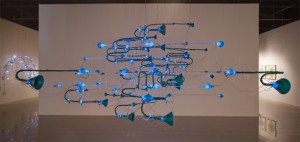Issue 28 11.20.13

Neuroscience, Memory and Art: Deborah Aschheim
by Sara Gevurtz
Neuroscience, Memory and Art: a Discussion with Deborah Aschheim
Deborah Aschheim is an artist who creates work that investigates memory, memory loss, and place. I had the opportunity recently to talk to her about her work, her experience dealing with the medical community, and what she is working on now.
Currently, she has a five-year survey at San Diego State University, called “Feeling-of-knowing.” She has collaborated with Lisa Mezzacappa to create many of the sound sculptures that are on display. Aschheim

Image courtesy of Deborah Aschheim.
likes to collaborate with musicians because she feels that the sound gives her sculptures a more “sensorial” or emotional feel. Her sculptures and installation encourage the viewer to interact with the sound and images that are being presented within the web-like structures. This hands-on aspect has to do with the body and grounding the memories in the physical world.
Aschheim studied anthropology during her undergrad, and has a history of Alzheimer’s disease in her family, which has been much of the motivation for her work. While doing a residency at Headlines Center for the Arts in Marin, she ran into an opportunity to investigate at the Memory and Aging Center at the University of California, San Francisco. Through this, she started going to the clinic on a regular basis, which eventually led to setting up a residency program at the center. During this time, she was able to meet with researchers and doctors there.
When I asked her what she thought about her experience at the memory center and whether she thought the medical community was open to having an artist around, she responded that it was a very important experience for her and that yes, for the most part, they were open to having her around. It appeared that because the center was located in San Francisco, a city known for arts and culture, and the fact that these were scientists interested in the brain, they were very open to arts and interested in what Aschheim was doing. During her time there, she was able to interview the researchers and even act as a sort of connection point between the researchers who were stationed throughout the city. As an artist, Aschheim was very well equipped for this role.
Aschheim met Indre Viskontas while at the center, a PhD student, who also happened to be an opera singer. This combination of art and science made her an ideal collaborator for Aschheim, and she will be participating at a panel discussion of Aschheim’s work in San Diego, CA.
Currently, she is at a residency at the Orange County Great Park, which is a new park in Irvine, CA, that now occupies the old El Toro Air Force base. Richard Nixon would fly in and out the El Toro Air Force base on Air Force One while he was president, and he flew back to El Toro Air Force base after resigning the presidency. Aschheim still remembers Nixon’s resignation, and it was a formative part of her childhood. In light of this, Aschheim interviews people about their memories of Richard Nixon as they go through the park, often hearing about the same “garbled, fragmented and distorted” memories of Nixon. In this new work Aschheim is starting to move beyond personal memory and into collective memory.
Not too long ago, the arts and the sciences were actually practiced side by side. Aschheim suggests that today the arts and the sciences can benefit each other, particularly when the artist is able to go into the realm of the elite scientist and perhaps bring the researchers back to reality. They accomplish this by interacting with the scientist and reminding them that not everyone understands the complicated jargon they take for granted. This therefore creates new and interesting dialogues around the science that can be funneled into the creation of the art.
Deborah Aschheim’s project is now viewable here: http://www.deborahaschheim.com/collections/view/346
Deborah Aschheim, telephone interview with the artist, November 4, 2011.